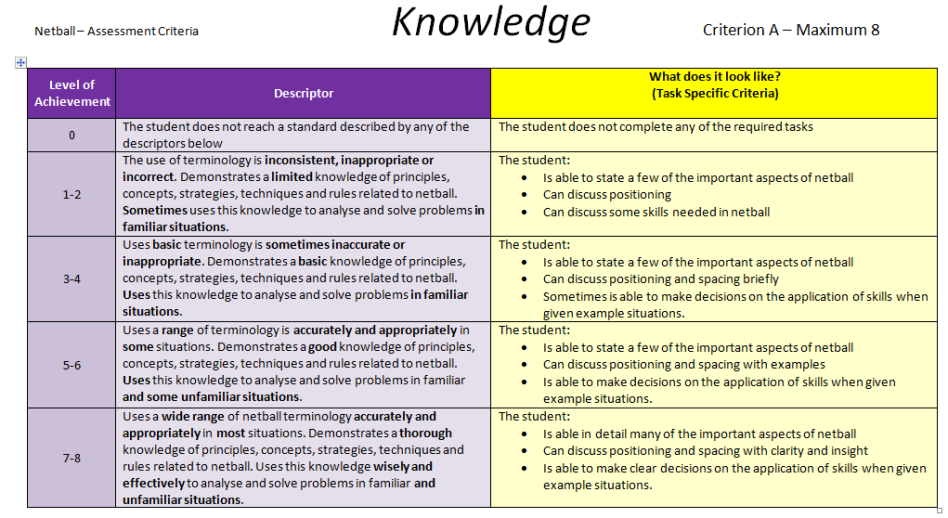Just remember that when including a rubric for an assessment task. You should include both the level descriptor (as stated by the IBO) and also the Task Specific Criteria (TSC). This will allow students a clear understanding of what they need to do in that specific unit to achieve a specific level. For example:
2019 MYP Curriculum
Fairly quiet on the blog for the last 12 mths but over the next few weeks term 1 units will be reviewed and slight modifications will be reflected in the uploads.
Please note that although these units have been developed by our school staff feel free to use these as a guide to develop and evolve your own MYP PHE curriculum.
If anyone is interested in sharing their own school’s MYP PHE curriculum documentation please contact me and we can create a new resource area for these resources to support the MYP PHE community on the blog.
Have a great year.
2018 Term 1 Units
Welcome back!
Term 1 units have been updated.
Any additional updates or changes to the units can be discussed with year level team members in the first week.
Be sure to update the s drive for group access of the most up-to-date version of the planners and assessment tasks.
Enjoy!
MYP PHE subject guide update
Update from the IB.
- Addition of “Development” as a focus key concept contributed by the subject group (making it eligible for use as key concept in partially completed unit plans for MYP ePortfolio assessment, and a required component of curriculum planning for physical and health education courses)
- Changes to strands i and ii of objectives/criteria B and D to better align planning and reflection
- Adjustment of command terms in some of the achievement level descriptors for criteria B, C and D
- Additional guidance on academic honesty in “MYP eAssessment”
How could I miss that?
Although this “Further Guidance for MYP PHE” document was published in Feb 2016… it looks like I missed it!
So for all the stress and frustrations around the similarities of Criterion B2 and Criterion D. It looks like we don’t have to worry about that anymore! Woohoo!
Below is a summary of the additional changes to the original MYP PHE Guide. I also believe the IB will be sending out an updated guide in 2018.
Physical and health education guide_further guide 2016
Summary
- We no longer need to assess criterion B ii
- However, we need to assess both physical and health performance in criterion B
- Planning for an aesthetic routine, once per year, for criterion B is still a requirement.
- Clarification of “unfamiliar” situations in physical performance (to achieve a 7 & 8)
- Clarification between “analysis”, “synthesis” and “evaluation” (to achieve a 7&8 in level 5)
- For our school we can ignore the eportfolio stuff as we don’t do this, we teach PHE as a distinct course. However, there will be some school that need to review the additional guidance for eportfolios.
Updated Curriculum 2017
All curriculum changes have been made for 2017.
Additions include:
- New curriculum mapping Years 7-10
- Planner overview document Years 7-10
- Attached assessment tasks for each unit
- Year 7 unit planners
- Invasion games unit planners
To be added in 2017:
- Year 8-10 unit planners
MYP Pocket Assessments (Criterion C)
Want a quick and effective way to assess students on Criterion C?
The idea of the ‘Pocket Assessment’ arose after conversation with staff about the difficulty of managing and engaging students whilst also thinking about the requirements of assessment.
Staff also felt MYP assessment was impacting on the engagement of students. The question posed was how could we increase student engagement during assessments while still achieving the MYP objective.
Set up your lesson where students can explore specific skill development or game strategies. Use a specific focus to assess students and while students are self-directed the teacher can complete the pocket assessment; taking notes on their performance. Ultimately, this formative assessment task, would be completed over a number of times throughout the unit.
Benefits:
Staff can reference the prompting questions and simplified rubrics on a single A4 sheet which can then be attached to a clipboard.
This simple task will allow staff to interact with students, question their understanding and continue to have students being physically active whilst completing assessment.
You have a quick references to students that haven’t been assessed.
It can be easily modifiable for different classes.
Adjustments:
More note taking space could be beneficial (easily rectified by increasing the space available for each student and having a double page spread)
Prompting questions – need to be updated for each the focus of the performance.
Example:
9level5pocketassessmentC (Template)
Concept Based Learning
Hopefully those staff who attended the Lyn Erickson PD on Friday (focussed on Concept Based Learning) got as much out of it as I did.
For those that didn’t attend, check out the youtube clip below.
What resonated with me was the Scaffolding thinking to complex levels and the web mapping for a specific unit.
Briefly,
When developing a Statement of Inquiry you can use the following scaffolding to evaluate the inquiry.
Example: Invasion Games (Statement of Inquiry)
Level 1: Movement impacts on space
Ask yourself–> How or why?
Level 2: Movement patterns determine the effectiveness of offensive or defensive strategies
Ask yourself –> So what – is the significance or effect?
Level 3: Teams with strong game sense gain competitive advantage
Evaluation
* Do the ideas grow in sophistication?
* Are the verbs active and present tense?
* Do the ideas become clearer from level to level because they are more specific?
* Are the ideas based on fact? Are they true?
* Are the ideas important?
* Did the writers answer their question at each level?
* Are the ideas developmentally appropriate?
Lyn Erickson 2011 (6:09)
MYP Unit Question
Tip 1
When creating a unit question, ask yourself, can you answer the following 2 questions?
1) Can the students answer it?
2) Can if be transferred to another subject area?
Tip 2
When creating a unit question use the words of the criterion in the question
For example:
If in a netball unit you were assessing Criterion A and D. Your unit question might look like:
“How can knowledge, skill and attitude improve performance?”
Tip 3
Make sure to use the unit question in the assessment task, so you can identify if students are able to answer it.
This could be part of a student self-reflection. Have the question somewhere in there.
Welcome to MYP Phys Ed
This blog is designed for teacher to collectively review MYP Phys Ed units.
It is difficult to find time for the learning area to meet in the same place at the same time and talk curriculum.
Hopefully this blog will help stimulate professional dialogue to review, evaluate and re-design units as we teach them.
It would be great to hear your feedback.

